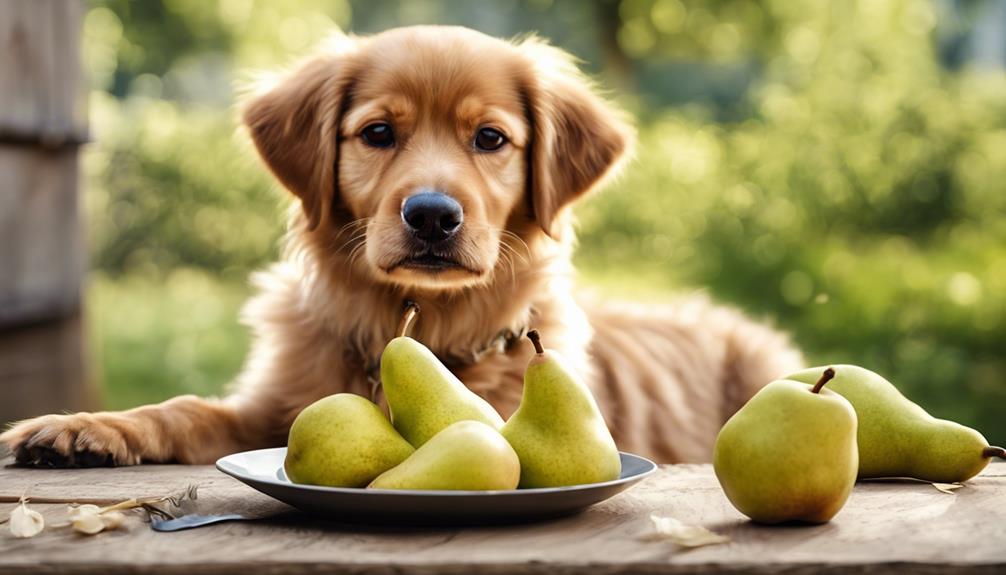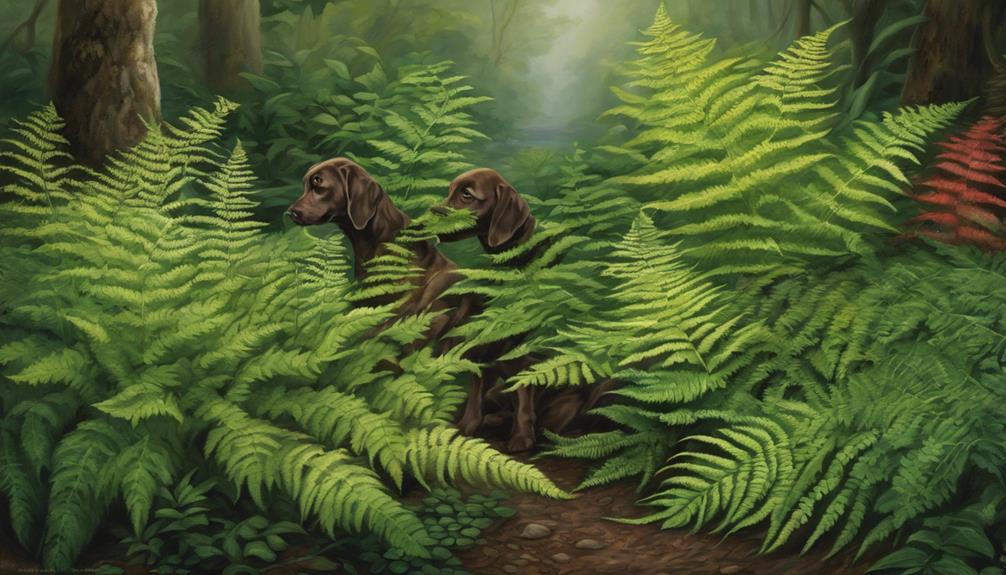Yes, dogs can have pears safely. Cut ripe pears into small pieces to prevent choking. Remove seeds and core to avoid cyanide exposure. Fresh pears are preferable to canned. Monitor closely to prevent choking or obstructions. Adjust portion sizes to avoid upset stomachs. Look for signs of allergies. Peel pears to make them safer to eat. Consult a vet before giving pears. Avoid large pieces that may cause issues. Supervise eating to avoid dangers. Following these steps guarantees safe pear enjoyment for dogs. Further insights on pear safety await.
Key Takeaways
- Cut pears into small pieces to prevent choking hazards.
- Remove core and seeds to avoid cyanide exposure.
- Monitor dogs while eating pears for safety.
- Fresh pears are better than canned for dogs.
- Consult a vet before introducing pears to your dog.
Pear Safety for Dogs
When considering the safety of pears for dogs, cutting them into small, bite-sized pieces is *vital* to prevent choking hazards. Dogs can enjoy pears safely as long as the seeds, which contain cyanide and pose a choking risk, are removed.
Fresh and ripe pears are the best option for our furry friends, steering clear of canned ones. Feeding whole pears to dogs can be risky, potentially increasing the chance of choking incidents. By slicing the pears into tiny pieces, we can help *guarantee* our dogs can savor this fruit without any harm.
Monitoring our dogs closely while they indulge in pears is also *essential* in preventing any choking mishaps. Remember, safety comes first when it comes to sharing pears with our canine companions. By taking these precautions and being mindful of the potential hazards, we can make sure our dogs enjoy this tasty treat without any worries.
Removing Pear Core and Seeds

Before giving pears to your furry friend, it's important to remove the core and seeds, as they can be harmful.
To make pears safe for dogs, cut them into small pieces after taking out the core and seeds.
Ensuring that no parts with seeds remain will help prevent any potential health hazards for your canine companion.
Core and Seeds Safety
To guarantee the safety of dogs when feeding them pears, always remember to remove the core and seeds before serving. Pear seeds contain cyanide, which is toxic to dogs and should be avoided. The core can also pose a risk of intestinal obstruction if swallowed whole.
Choking hazards can be minimized by cutting the pears into small, manageable pieces for your furry friends. Opt for smaller pieces, especially with larger pears, to lower the risk of obstruction. It's essential to make sure that dogs don't ingest the seeds, as they can be harmful in large quantities.
Proper Pear Preparation
For ensuring the safety of dogs when feeding them pears, it is essential to properly prepare the fruit by removing the core and seeds. When a dog eats pears, cutting them into small, bite-sized pieces is essential to prevent potential obstructions in their digestive tract. Larger pieces pose a higher risk of obstruction, so opting for smaller portions is key. Remember, pear seeds are toxic to dogs due to the cyanide they contain, making it important to ensure that all seeds are fully removed before feeding your furry friend this fruit. By following these steps, you can safely offer pears as a treat to your dog without risking their health.
| Preparation Steps | Importance |
|---|---|
| Remove core and seeds | Prevents choking hazards |
| Cut into small pieces | Avoids digestive tract issues |
| Ensure no toxic seeds | Protects your dog's health |
Dog-Friendly Serving Sizes
Considering the health and safety of our furry companions, it's essential to make sure that pear serving sizes for dogs are appropriately tailored by removing the core and seeds.
Small dogs, in particular, can benefit from having fresh pears as a healthy snack, but it's important to cut the fruit into small, manageable pieces to prevent choking hazards.
The sugar content in pears can cause upset stomachs if consumed excessively, so moderation is key when offering them as dog treats.
Moderation in Pear Feeding

When feeding pears to your furry friend, remember that moderation is essential. It's important to control the portions to prevent potential digestive issues that can arise from excessive sugar consumption.
Keep a close eye on your dog for any signs of allergies or sensitivities when introducing pears into their diet.
Portion Control Importance
Maintaining proper portion control when feeding pears to dogs is crucial to prevent digestive issues and promote their overall health. Dogs should only have pears as a small part of their diet, making sure it doesn't exceed 10% of their daily food intake.
Overfeeding pears can lead to problems like an upset stomach or unwanted weight gain in our furry friends. By monitoring the amount of pear given, we help guarantee they maintain a balanced diet. Moderation is key in feeding pears to dogs, allowing them to enjoy the benefits without any negative effects.
Potential Digestive Issues
Properly controlling the amount of pears given to dogs is essential in preventing potential digestive issues. When considering feeding your furry friend this tasty fruit, remember these key points:
- Moderation is Key: Dogs eat pears, but too much can cause digestive upset.
- High Sugar Content: Pears are high in natural sugars, which can lead to stomach discomfort if overfed.
- Monitor Your Dog: Watch for any signs of digestive issues like upset stomach or diarrhea.
- Adjust Intake: If you notice any problems, reduce the amount of pears given and monitor your dog's reaction closely.
Monitor for Allergies
To safeguard our dogs' well-being, we must be diligent in monitoring for any signs of allergies when incorporating pears into their diet. Start with small amounts of pear to guarantee your dog tolerates it well. Remember, moderation is key to prevent potential digestive upset. Watch your dog closely for any negative reactions like itching, swelling, or changes in stool consistency.
If you notice any discomfort or allergic symptoms after feeding pears, consult your veterinarian for guidance. Our furry friends' health is a top priority, so observing them for any adverse effects when introducing new foods like pears is essential. By staying alert and responsive to their reactions, we can ensure a safe and enjoyable feeding experience for our beloved companions.
Skin Removal for Safety

Ensuring the safety of your dog when feeding pears involves removing the skin to prevent potential hazards. Here's why skin removal is important:
- Choking Hazards: The tough skin of a pear can be a choking risk for your furry friend. Removing it reduces this danger significantly.
- Digestibility: Dogs may find the skin hard to digest, leading to potential stomach issues. Peeling the pear ensures they only consume the safe and digestible flesh.
- Pesticide Residue: The skin of a pear may harbor pesticide residue, which can be harmful to dogs if ingested. Removing the skin decreases the risk of pesticide exposure.
- Safety Precaution: Peeling the pear is a simple yet effective safety measure to protect your dog from any harmful substances that could be present on the skin.
Fresh Vs. Canned Pears

Which type of pears is more suitable for dogs, fresh or canned?
When considering your furry friend's well-being, fresh pears are the way to go. Fresh pears contain lower sugar levels and fewer additives compared to their canned counterparts. Canned pears often come packed with added sugars and preservatives that can upset a dog's stomach. Opting for fresh pears guarantees that your dog receives the natural benefits of this fruit without the risk of gastrointestinal discomfort from the syrup or other additives commonly found in canned varieties.
Additionally, fresh pears retain more nutrients, making them a healthier choice for your canine companion. So, when it comes to treating your dog with pears, stick to the fresh ones to keep their digestion happy and provide them with the wholesome goodness of this delicious fruit.
Consult Vet Before Feeding

Before introducing pears into your dog's diet, consulting a vet is vital to ensure their safety and well-being. Here are some reasons why seeking professional advice is essential:
- Personalized Advice: Vets can provide tailored recommendations on the right amount of pears to feed your dog, considering factors like size, age, and dietary requirements.
- Preventing Potential Issues: Professional guidance can help avoid digestive problems or allergic reactions that may arise when introducing new foods like pears to your dog.
- Safe Introduction: Vets can advise you on how to safely incorporate pears into your dog's diet, guaranteeing a smooth change and monitoring their response to this new treat.
- Informed Decisions: By consulting a vet, you can make educated choices about including pears into your dog's diet responsibly, enhancing their overall health and well-being. Remember, your vet is there to assist you in making the best decisions for your furry friend!
Intestinal Blockage Risks

To prevent intestinal blockage risks in dogs, it's essential to be aware of the potential hazards associated with pear cores and seeds. If swallowed by dogs, pear cores with seeds can lead to serious intestinal issues. It's critical to avoid allowing your furry friends to ingest pear seeds to prevent blockages.
Larger pear varieties pose a higher risk of intestinal blockage, so it's best to cut pears into small, seedless pieces to reduce this risk. Monitoring your dogs closely while they enjoy their pear treats can also help prevent any potential intestinal issues that may arise.
Choking Hazards Prevention

Slicing pears into small, bite-sized pieces is important to prevent choking hazards in dogs. When giving your furry friend this treat, remember to follow these critical steps to keep them safe:
- Cut into small pieces: Make sure the pear pieces are small enough for your dog to eat without the risk of choking.
- Remove skin and core: Get rid of the skin, stem, and core with seeds to avoid any potential obstructions.
- Monitor closely: Always supervise your dog while they enjoy their pear treat to prevent any choking incidents.
- Limit intake: Treats like pears should make up no more than 10% of your dog's daily caloric intake to prevent choking and digestive issues.
Importance of Responsible Feeding

Ensuring our dogs receive a balanced diet that meets their nutritional needs is vital for their well-being. Responsible feeding involves more than just putting food in their bowls; it's about providing the right nutrients in the right amounts. Tailoring their diet to their age and health requirements is essential.
Monitoring portion sizes is important; just like us, dogs can overeat. Be mindful of the treats given, as they can add up quickly and affect the overall balance of their diet.
Seeking veterinarian guidance on important feeding practices can help you navigate the complexities of your dog's dietary requirements. Consulting with a professional guarantees that your furry friend is getting everything they need to thrive and can prevent potential health issues down the line.
Frequently Asked Questions
Are Pears Toxic to Dogs?
Pears aren't toxic to dogs, but caution is needed. While the fruit itself is safe, the seeds contain cyanide, which can be harmful.
To keep dogs safe, it's crucial to remove the seeds before offering them pears. Avoid giving dogs the core to prevent any potential risk.
Stick to the flesh of the pear to guarantee your furry friend stays healthy and happy.
Can Dogs Have Pears With Skin?
We suggest providing pears without the skin to dogs to prevent potential choking hazards.
While the skin is safe for dogs to consume and contains beneficial fiber and nutrients, some dogs may have difficulty digesting it.
If your furry companion likes pear skin, offer it in small, manageable pieces.
Always supervise your dog when giving them pears with skin to make sure they can chew and swallow safely.
What Are the Healthiest Vegetables for Dogs?
We'll explore the healthiest vegetables for dogs.
Carrots, high in fiber and beta carotene, promote good dental health.
Sweet potatoes, rich in fiber, vitamins, and antioxidants, benefit overall well-being.
Green beans, low in calories but packed with nutrients, aid in weight management.
Peas, a good source of essential vitamins, minerals, and protein, support a balanced diet.
Cucumbers are hydrating, low in carbs and fat, and provide essential vitamins and minerals.
Which Fruits Are Good for Dogs?
Fruits, like apples, bananas, blueberries, cantaloupe, and mangoes, are great for dogs because of their vitamins, fiber, and antioxidants.
Apples provide vitamins A and C, while bananas offer potassium and fiber. Blueberries are a superfood for dogs due to their high antioxidants. Cantaloupe and mangoes are nutrient-dense, low-calorie fruits with essential vitamins.
These fruits are beneficial for our furry friends' health and well-being.
Conclusion
To sum up, remember to practice pear safety for your pooch. Remove core and seeds, feed in moderation, and consult a vet before feeding.
Prevent choking hazards and intestinal blockages by removing skin and choosing fresh pears over canned. Responsible feeding is key to keeping your furry friend healthy and happy.
Remember, pear safety is paramount for your precious pet!










